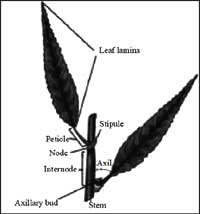NEW! The Gist (FREE) | E-BOOKS |
(Sample Material) IAS PRE GS Online Coaching : General Science - "Photosynthesis"
Sample Material of Our Online Coaching Programme
Subject: General Science
Topic: Photosynthesis
INTRODUCTION
Photosynthesis is the process by which plants, some bacteria, and some protistans use the energy from sunlight to produce sugar, which cellular respiration converts into ATP, the “fuel” used by all living things. The conversion of unusable sunlight energy (solar energy) into usable chemical energy, is associated with the actions of the green pigment chlorophyll. Most of the time, the photosynthetic process uses water and releases the oxygen .We can write the overall reaction of this process as :
![]()
The above chemical equation translates as: Six molecules of water plus six molecules of carbon dioxide produce one molecule of sugar plus six molecules of oxygen.
STRUCTURE OF LEAF
- Plants are the only photosynthetic organisms to have leaves (and not all plants have leaves). A leaf may be viewed as a solar collector crammed full of photosynthetic cells.
- The raw materials of photosynthesis, water and carbon dioxide, enter the cells of the leaf, and the products of photosynthesis, sugar and oxygen, leave the leaf.
- Water enters the root and is transported up to the leaves through specialized plant cells known as xylem.
- Land plants must guard against drying out (desiccation) and so have evolved specialized structures known as stomata to allow gas to enter and leave the leaf. Carbon dioxide cannot pass through the protective waxy layer covering the leaf (cuticle), but it can enter the leaf through an opening (the stoma; plural = stomata; Greek for hole) flanked by two guard cells.
- Likewise, oxygen produced during photosynthesis can only pass out of the leaf through the opened stomata.

- Unfortunately for the plant, while these gases are moving between the inside and outside of the leaf, a great deal water is also lost.
- Cottonwood trees, for example, will lose 100 gallons of water per hour during hot desert days. Carbon dioxide enters single-celled and aquatic autotrophs through no specialized structures.


